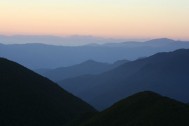Rule Number 1. Stay in the game!
I was once asked why I don't take a desk job and quit all this fieldwork. The question was posed by a doctor who was in the process of answering my previous question, namely "why does my knee not work?" How could I explain to him that conservation, like war, is fought and won in the field, regardless of how many clever people there are strategizing the invasion or planning the means of defense if there aren't any people on the front line you pretty much don't have a war anyway. Likewise if no body is in the field monitoring endangered species population and intervening when required you might as well sit at home and survey for parrots using Google Earth. Face it there really is no substitute for time in the field. With that fact firmly established we reach the true crux of the problem. How do we stay in the game long enough to make a difference?
You need to be out there, hitting the track everyday with people of various ages to see the kind of damage we field biologist sustain in the "war on extinction". Broken arms, torn knees, twisted ankles and strained ligaments to name a few. So rather than ask "why do we do it" we are forced to ask "how can we keep doing it?" How are there still people out there like my good friend Don Merton running around the hills at a ripe age of 60 something. When I look back on ten years of conservation work I have to ask myself was there ever a point when it was nearly too much. There have been many close moments including having to jump from a helicopter, side step an angry snake, risk the jaws of a grumpy sea lion or suffer the stings of a venomous spider. However while I'm not the crocodile hunter fieldwork does carry various inherent risks. That was why the events of March 2007 came as no surprise despite the unexpected way they unfolded.
I was working for the Research and Development sector of New Zealand's Department of Conservation. We were taken by helicopter up to a hut at the 1000m tree line of Parapara Peak in limestone country.
The steeply cut Parapara Ranges
We were given the task of setting out mammal tracking lines in harsh rugged untracked bush. The valleys were 800m deep and carved into bluffs and bottomless caverns. The vegetation was thick and at times impenetrable and my problems started with a wasp sting. Well 10 wasp stings actually, it appeared I had stood on a nest. My knees where seething with little yellow and black striped bodies. What could I do other than head straight for thick vegetation and push my way through. Theoretically the wasps can't follow you, theoretically there is suppose to be solid earth on the other side. Yes it started with the wasps by perhaps it was cemented by the 7m cliff. Imagine, me there stretched out into the void with my foot hooked into a plant root and my back stung by the wasps that weren't suppose to have been following me. It could have ended there but instead I reached for the base of a tree at the top of the cliff, released my foot just in time for the rotten tree to come away in my hand...
The good news was the wasps had given up the chase. The bad news was I was falling, quickly, into the darkness. Scheduled to land on the rocks 7m below me. So far I was sure to make that appointment but when my body flipped in the air and I was travelling head first and backwards I doubted that there was going to be an amicable outcome of the meeting of young Brent and Mr Earth. Suddenly there was darkness, had I closed my eyes? Was I blacking out? All I knew was the feeling of falling, the rushing of air about by body, the desire to have my feet lower than my head and the fact that all was silent and my eyes were filled with blackness. Then I hit! Hard! And everything changed...

































